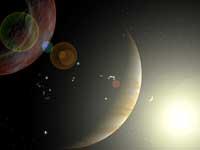A planetary system similar to ours has been detected
Most of the exoplanets observed so far are very large, orbit very close to their star and have an eccentric orbit. On the other hand, in the Solar System, the planets of this magnitude are quite far from the Sun, so it cannot be said that they look much like our system. However, according to astronomers, that the observed exoplanets are of this type does not mean that they are the most common, but that they are easier to detect.

Now, astronomers from the University of California and the Carnegie Institute of Washington have revealed that they have discovered another 15 exoplanets, a total of 90. The one that has aroused the interest of astronomers is four times greater than Jupiter and 55 Cancri is located at a distance of 5.5 astronomical units (AU) of its star, that is, something further away from the Sun (it must be noted that an AU is the average distance between Earth and the Sun and there are 5.2 UAS between Jupiter and the Sun). On the other hand, the orbit of Jupiter lasts 11.89 years and that of this exoplanet, 13. Thus, although the 55 Cancri star system is far away, it is much like the solar system. However, parity ends there, in addition to this huge planet, because near the star there are two other great planets, one of them at only 0.12 AL and the other at 0.24 AL.
To explain how large planets can be so close to their star, there are currently two main theories. Astronomers are studying more than 1,200 stars and there is still a lot of data to know what the correct theory is. Therefore, we will have to wait a bit to clarify if there is anyone else that looks like our planet.
To find out more click here .
Buletina
Bidali zure helbide elektronikoa eta jaso asteroko buletina zure sarrera-ontzian










